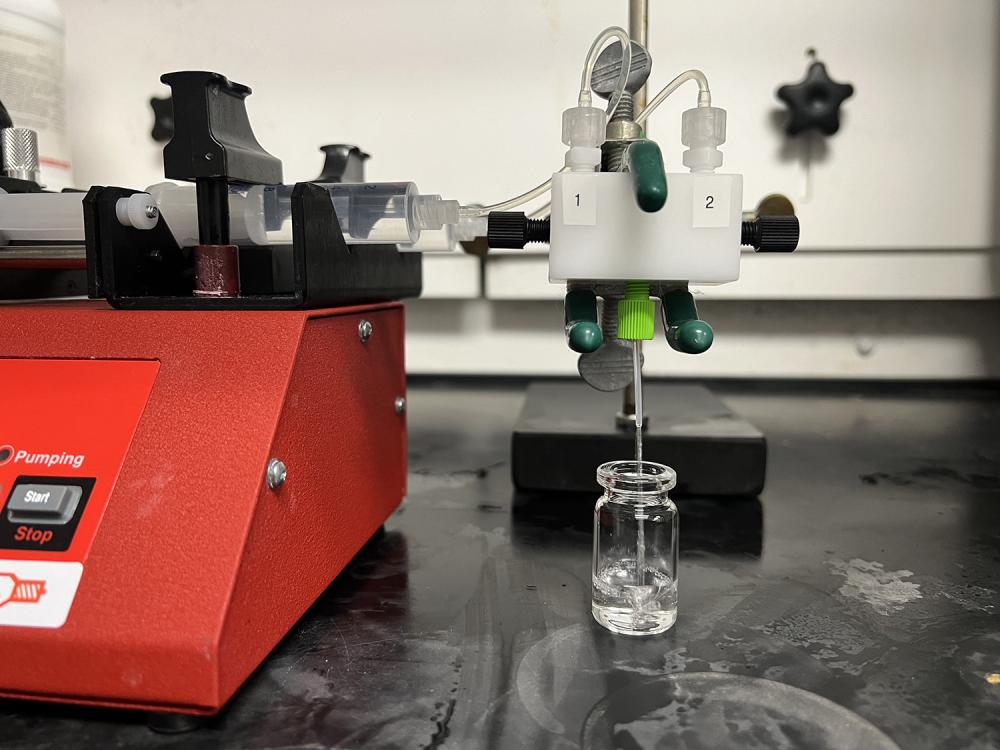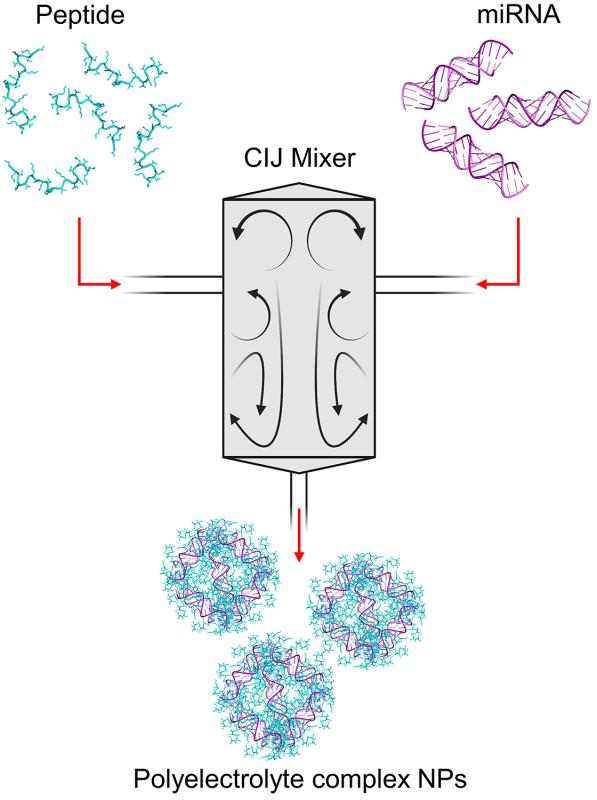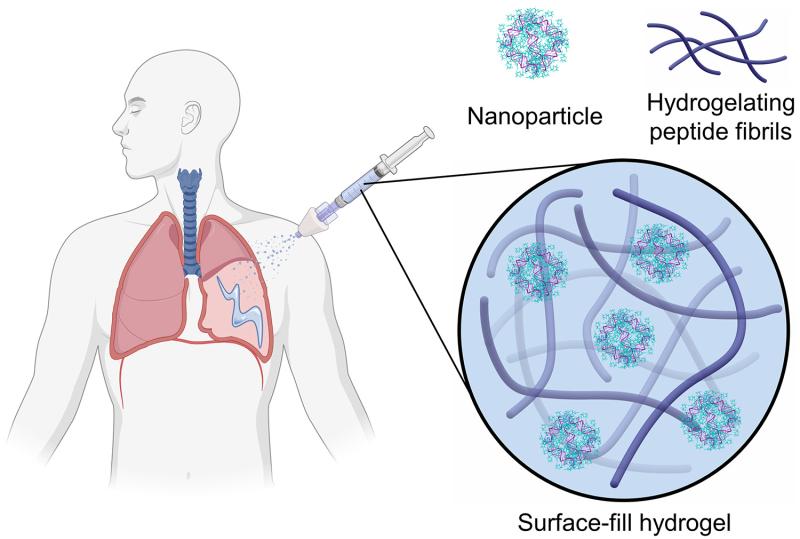A scientist pushes a small gray button on a red metal box, activating a pump that shoots clear fluids from two syringes into a small compartment just a few square centimeters in size. From there, the mixture is forced through a thin tube into a thumb-sized glass vial, where it pools with a few small bubbles.
That scientist, Caleb Anderson, Ph.D., a postdoctoral fellow at NCI Frederick’s Chemical Biology Laboratory, was hired to solve a problem, and this machine and its contents represent the solution he has spent months designing, calibrating, and testing. The mixture contains tens of thousands of nanoparticles of a developmental novel therapeutic agent targeting mesothelioma, an aggressive form of cancer that affects the surface tissue lining various organs, such as the lungs. The machine can make up to 7,200 doses per hour.
This novel type of cancer therapeutic was first developed in 2021 by a team headed by basic sciences researcher Joel Schneider, Ph.D., laboratory chief of NCI Frederick’s Chemical Biology Laboratory, and thoracic surgeon Chuong Hoang, M.D., FACS, an investigator at the NCI Center for Cancer Research’s Thoracic Surgery Branch.
The treatment, given as a single application, uses microRNA embedded in nanoparticles engineered to target and destroy cancer cells while avoiding healthy cells. It gets combined with a hydrogelating peptide, a collection of amino acids that adds the finishing step, transforming the mixture into a shape-changing substance called a surface-fill hydrogel. The gel can be injected with a syringe or sprayed on like paint—an ideal approach for treating mesothelioma, which forms and spreads over large areas on organs in a sheet-like shape.
Though encouraging, the initial therapeutic nanoparticle design was unstable over time, creating challenges for future scale-up or production. To solve this problem, the team hired Anderson, a chemical and biomolecular engineer with niche expertise they didn’t have.
“Rebranding” a New Technique
Originally, the nanoparticles were made using bulk mixing, which stirs the microRNA and peptide solutions together like cake batter. The negative charge of the microRNA naturally binds to the positive charge of the peptide, creating the building blocks of the nanoparticles. However, in the charged chaos of the chemical slurry, the building blocks assembled into nanoparticles with inconsistent sizes and stabilities.
There needed to be enough charge from the peptide to encapsulate the microRNA, but not too much or the building-block complexes wouldn’t condense with their neighbors to form nanoparticles. However, if the residual charge left over on the nanoparticle surface wasn’t high enough, the particles clumped together when they collided in solution.
Anderson was tasked with finding the Goldilocks balance to get stable nanoparticles. After studying the nanoparticle’s design, he altered its chemical composition and manufacturing process.
He proposed using flash nanocomplexation, a new technique in which two components are rapidly combined at high velocities in a small space using a machine called a confined impinging jet mixer. The method would give the team more control over how the nanoparticles formed.
Other scientists had used the technique before, but there was no protocol for this specific process. The team was the first to try it with such small particles: “a rebranding of the technique in the context of forming peptide-based polyelectrolyte complexes,” said Anderson.
So, they started tinkering—recalibrating the process, testing different velocities to figure out which would create the right mixing effect, and examining different ratios and concentrations of the microRNA and peptide molecules to see which would give the best results.
Their goal, according to Anderson, was to mix the two so quickly that they’re “right next to their binding partner almost instantly … [and] essentially ensure that most of the particles are pretty identical to each other as opposed to having broad size distributions,” yielding batch-to-batch reproducibility and nanoparticles that are very similar in size.
Additionally, to produce a stable nanoparticle solution, microRNA needs to be paired with just the right peptide. Anderson tested a family of six peptides to explore how their charge states affected the nanoparticles’ stability, and, in the words of Schneider, found his “magic bullet” in a peptide called PKM1.
One Milestone on a Long Road
The team was happy to celebrate their success, but curiosity led them further.
Anderson wondered if the nanoparticles could be freeze-dried for easier shipping and for storage so they could be made before they were needed. With some more work, the team found a preservation method that would make the product shelf-stable for up to three months without reducing its effectiveness.
Schneider said, “Right now we’re happy with this accomplishment. But the road to clinical trials is a long one. ... And so, I’m sure we will have many more challenges along that road.”
Nevertheless, this success marks a major “technical milestone” in the field of microRNA delivery, said Hoang, along the path toward what the team hopes will lead to U.S. Food and Drug Administration approval for further testing.
For now, next steps include more tests to make sure the therapeutic’s components are safe. Hoang and his team are also coordinating the creation of a prototype device that could be used to apply the surface-fill hydrogel directly to a patient’s mesothelioma.
Independent Scientists, One Collective Goal
Of note is that the postdoctoral fellows spearheaded the project, said Schneider: “[Hoang] and I kind of sat back and let the fellows go … I want to emphasize that these kinds of collaborations offer a unique training opportunity for our fellows, and the environment here at the CCR really enables those types of collaborations to take place … and creates really independent scientists.”
The collaborative spirit was key to uniting the different areas of expertise that the project required. Schneider’s team brought an understanding of the mechanics of polymer design and development. Hoang’s team’s skillset included knowledge of microRNA discovery and therapeutic translation as well as clinical expertise in mesothelioma of the chest. Anderson was able to bridge the two groups with his expertise in chemical and biomolecular engineering.
Hoang said, “It’s a coming together of many diverse technical and biologic disciplines that have enabled this product. That’s the unique aspect of NIH—it allows you to exist at these interfaces of science and medicine.”
Anderson said, “Having something where the clinicians have this problem that they need help solving … and it just so happens that you study and do the thing that can help solve those problems. … [It’s] validating to be able to work toward that collective goal. ... That is what really excites me, the possibility that [someday our work] can help change a lot of lives in the clinic.”
Editor’s Note: The figures were reproduced here with permission, obtained from the original publication: C. F. Anderson et al., Kinetically Controlled Polyelectrolyte Complex Assembly of microRNA-Peptide Nanoparticles toward Treating Mesothelioma. Adv. Mater. 2024, 36, 2314367. https://doi.org/10.1002/adma.202314367. Copyright © 1999-2024 John Wiley & Sons, Inc., or related companies. All rights reserved, including rights for text and data mining and training of artificial intelligence technologies or similar technologies.
Karolina Wilk is a technical editor in Scientific Publications, Graphics & Media (SPGM), where she writes for NCI Frederick and Frederick National Laboratory’s news outlets and edits scientific manuscripts, corporate documentation, and other writing. SPGM is the facilities’ creative services department and hub for editing, illustration, graphic design, formatting, and multimedia training and support.




